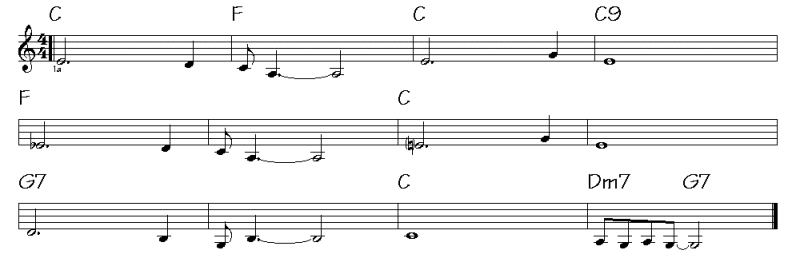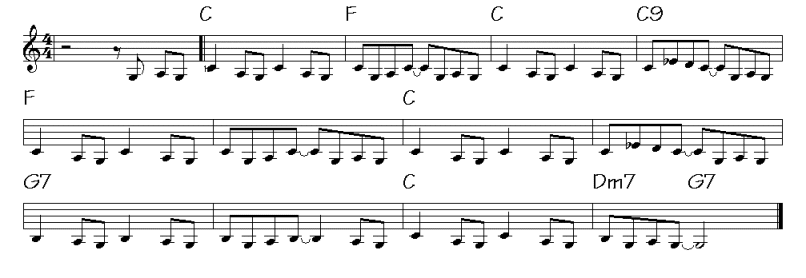Overview | Go to the player | Next
Blues
The 12 bar blues is a very simple harmony change. It is ideal for learning out to improvise for many reasons
- It is very simple harmony shift
- It is used in a lot of jazz and rock music
- It is well known to most musicians, that is if you want to "jam" you can always play a blues
You can r ead more about the blues progression here
Start with some blues licks
If you have not improvised before you will feel confident by learning some licks. Below some notes for the first two improvisations
Improvisation 1

The first four bars are basically in C major. The lick starts on the E, which is the third in the C-scale. The main notes of the lick are thus coming from the triad the forms the C-chord.
In bar 5 the blues goes into the subdominant (F) The lick now uses Eb which is the 7th in the F-scale and thus a very carecteristic of the F-scale
In the 9th bar the blues chord goes in to the dominant (G7) and we now takes the fifth of the G-scale (D) as starting note. Se how the lick now modulates into the triad notes of the G-scale. In bar 12 we end on a G. It is a very good idea to end on the Dominant note. (Like anything in improvisation you don't have to but if you can't find anything better, end on the dominant!!. Remember when you have played the last note of your solo this is when the audience are going to applause, so you want to get that note right.
Improvisation 2

This is a simple theme that I like a lot. It is very easy to remember, and you can always fall into it for a while. Look how bar 5-8 are exactly looking like bar 1-4!
Don't be afraid of repeating yourself when making solos. All music is built on repetition. The difference comes when you are playing the same over the same cords.
Actually bar 9-12 are rhythmically the same, the notes has just changed slightly to match the G7 chords. So bar 9-12 are repetition with a small variation. When you have learnt this piece, try to vary it a litle bit by changing the duration or pitch of just one note. Make another lick which looks alike it.